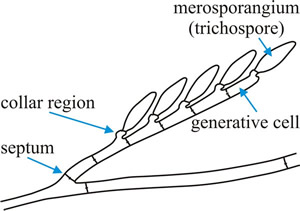16.3 Trichomycetes
Microsporidia are fungi that were long thought to be protozoans, and are still called protozoans by many people who should know better. Trichomycetes, on the other hand, includes organisms that are clearly protozoans though they were mistakenly classified as fungi for a long time, and are still called fungi by many people who should know better.
These extremely common organisms live only in the digestive tracts of insects and other arthropods, generally as commensals, sometimes as pathogens or symbionts (mutualists), which are associated with, although not penetrating, the cuticle lining the digestive tracts of the host animal. Their hosts include terrestrial, marine and freshwater arthropods, most commonly midges (Chironomidae), mosquitoes (Culicidae), black flies (Simuliidae), beetles (Coleoptera), stoneflies (Plecoptera), and mayflies (Ephemeroptera), as well as several millipedes (Diplopoda) and crustaceans.
The traditional taxonomy is based on a few micromorphological characters and the traditional view was to place the class Trichomycetes in the zygomycetes, the class being divided into four orders:
- Amoebidiales (which occur on the external surfaces of freshwater arthropods),
- Asellariales,
- Eccrinales, and
- Harpellales.
Characteristically the Trichomycetes develop nonseptate (in the Amoebidiales and Eccrinales) or irregularly septate (in the Harpellales and Asellariales) vegetative mycelia and asexual sporangia. Further, most genera of the Harpellales produce zygospores and it is this character which was used to include all the Trichomycetes among the zygomycete fungi. The Amoebidiales and the Eccrinales have now been removed from this association; they are not fungi, but they are close to the phylogenetically-ancient animal-fungal divergence (Reynolds et al., 2017).
The Amoebidiales are amoebae-producing organisms that attach to the exoskeleton of freshwater arthropods (Amoebidium parasiticum was the first described). Production of amoebae is not otherwise present in kingdom Fungi. More significantly, A. parasiticum has stacked dictyosomes, which do not occur in fungi, and lacks chitin in its cell wall. Taken together these features do not make it a good candidate as a fungus. The Eccrinales have unbranched, non-septate, multinucleate thalli, and produce sporangiospores, which form from the apex downward toward the base of the thallus, a feature found only in kingdom Fungi. These few distinctive morphological characters together with the fact that they share a very specialised ecological niche with genuine fungi like the Harpellales was all that classified them within the Trichomycetes. Now, sequence analyses have shown that the Eccrinales share a common ancestry with the Amoebidiales, and are closely related to members of the protist class Mesomycetozoea, which is positioned at the animal-fungal boundary in the opisthokont lineage (Mendoza et al., 2002; Cafaro, 2005; Reynolds et al., 2017).
Removing these fungus-like protists leaves the trichomycetes consisting of the Harpellales and Asellariales. These are true fungi having hyphal thalli with cell walls containing chitin fibrils and being regularly septate with incomplete septa having a plugged central pore. No confirmed sexual stage has been reported generally for the Asellariales, although conjugation has been reported between cells of the one species Asellaria ligiae. Generally, in the Harpellales, though, zygospores (biconical and apically thickened when mature; CLICK HERE to see a page of illustrations) are formed following conjugation between cells of the same, or different thalli, being borne at the apex of zygosporophores. Phylogenetic analyses confirm that the Harpellales and Asellariales both belong to the subphylum Kickxellomycotina which is now placed in in phylum Zoopagomycota (see our earlier discussion in Section 3.5).
A major difficulty for study of these organisms is that they are microfungi which are highly specialised for attachment the gut wall of arthropods and they are obligate endosymbionts; consequently, very few of them can be cultured axenically (i.e. in pure culture) although this is needed to prepare fungal macromolecules free of contaminating host molecules. Only eight of the 38 genera of Harpellales have been cultured, but none of the Asellariales (Tretter et al., 2014).
The unique trichospores, for which the class is named, are the asexual spores. Harpellales produce branched or unbranched thalli, and either the entire thallus or lateral branches of it become regularly septate at maturity to form a series of uninucleate generative cells. From the apical region of each generative cell a single unisporous merosporangium is produced; this is the trichospore (Fig. 3). In many genera the merosporangia are borne on short lateral branches, which form the collar region of the generative cell. Members of the Asellariales do not produce deciduous merosporangia but the regularly septate branches fragment into single-celled arthrospores. In some species of Asellariales the arthrospores germinate by producing a single branch, similar in position and form to a trichospore.
 |
Fig. 3. Diagram of the general pattern of asexual reproduction in Smittium (Harpellales). Redrawn after Moss & Young, 1978. |
These insect gut fungi occur worldwide in all habitats; effectively they have been found whenever they have been looked for. The Harpellales are predominantly associated with larval aquatic insects, and, occasionally, with freshwater isopod crustaceans, attached to the midgut or hindgut linings.
They also attach to the midgut linings of lower dipterans (Nematocera, which includes mosquitoes, crane flies, black flies, gnats and midges), mayflies (Ephemeroptera), stoneflies (Plecoptera), beetles (Coleoptera) and caddisflies (Trichoptera).
The Asellariales includes species that inhabit terrestrial, freshwater and marine isopods (Isopoda: Crustacea) such as woodlice, pill bugs, and sea slaters; as well as the hexapod springtails (Collembola) that are primitive relatives of insects.
They are most often described as being symbiotic with their hosts but the nature of the association is not at all clear. Certainly, the fungi are highly specialised for existence within the arthropod guts, so they may be commensals (an association in which one species derives some benefit while the other is unaffected). But as fungi they are able to produce many digestive enzymes so this may be a mutualistic symbiosis in which the fungus provides nutrients to the insect hosts by assisting with food digestion. A few species appear to be parasitic at some stage of the host’s development. All the evidence suggests that only a fraction of the species of arthropod gut fungi is known.
Updated July, 2019
